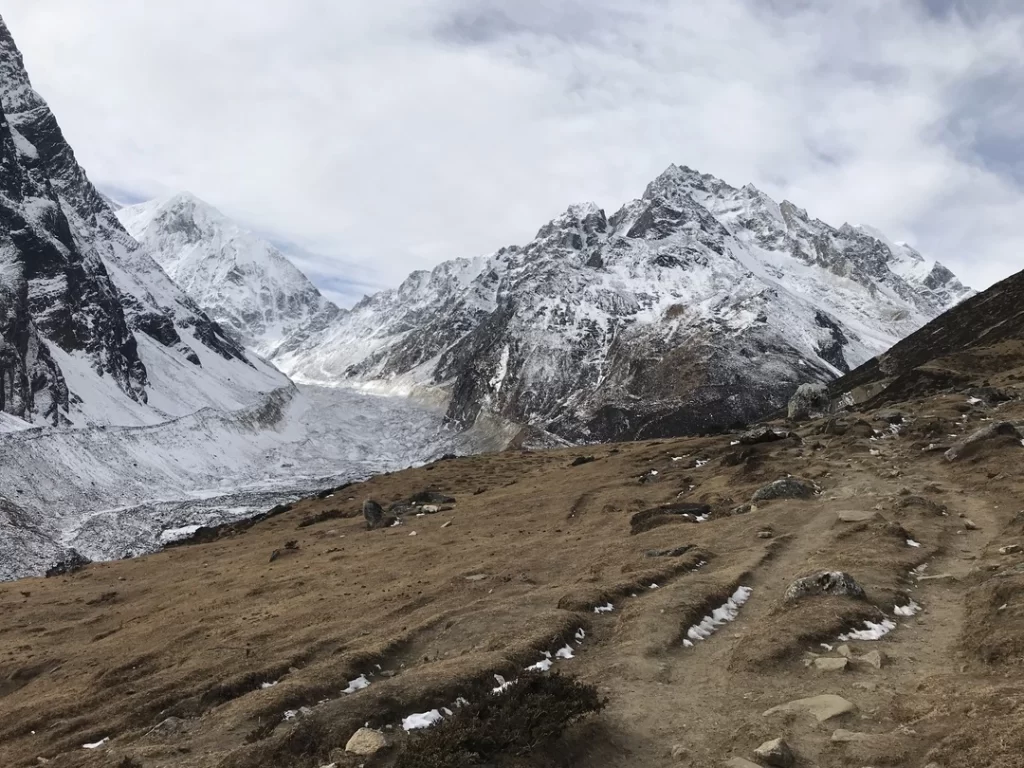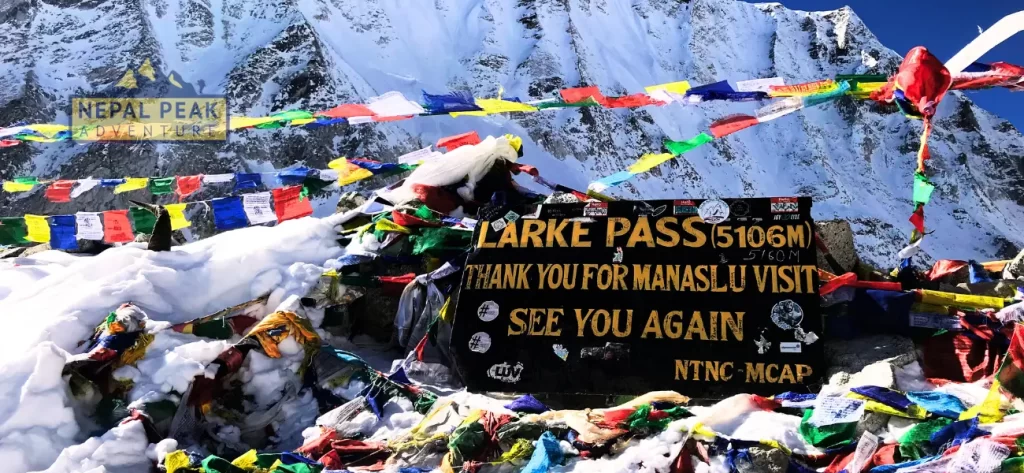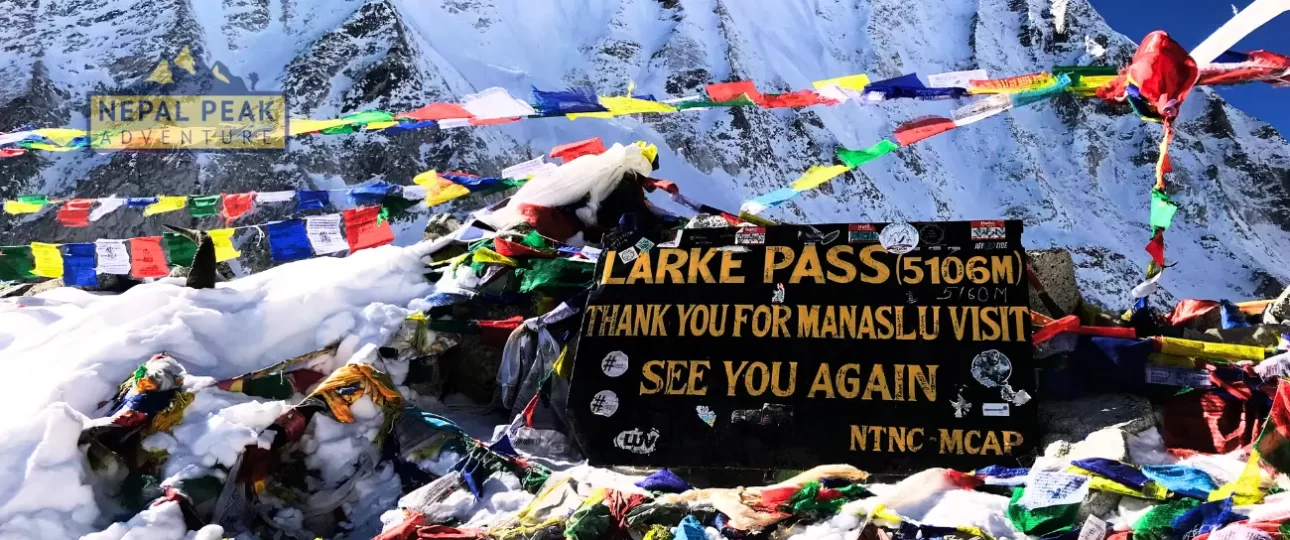Larke La Pass 5,106m: A Journey Through Nepal’s Majestic Highlands
Nestled within the heart of the Himalayas, Larke La Pass, also known as Larkya La Pass, stands as one of Nepal’s most awe-inspiring high-altitude crossings. At an elevation of 5,106 meters (16,752 feet), this pass is a prominent feature of the Manaslu Circuit Trek, offering trekkers an unparalleled adventure through diverse landscapes, rich cultures, and breathtaking vistas.
Larke La Pass is more than just a high mountain pass; it’s a gateway to the stunning beauty of the Manaslu region. The journey to this lofty point is an expedition through an array of ecosystems, from subtropical forests at lower elevations to the rugged, wind-swept alpine terrain near the pass itself. The views from Larke La are nothing short of spectacular, with panoramic sights of majestic peaks like Himlung Himal, Cheo Himal, Kang Guru, and the distant Annapurna II.
Trekking the Manaslu Circuit
The Manaslu Circuit Trek, encompassing Larke La Pass, is renowned among trekking enthusiasts for its challenging yet rewarding trails. This trek offers a less crowded alternative to the more popular routes like the Annapurna and Everest circuits, providing a more serene and immersive experience. The journey typically begins in the town of Soti Khola and winds its way through picturesque villages, terraced fields, and verdant forests before reaching the higher, more rugged landscapes near Larke La.
How difficult is Larke La Pass?
Larke La Pass, also known as Larkya La Pass, is a formidable challenge even for seasoned trekkers. Its elevation, weather conditions, and terrain contribute to its reputation as one of the more difficult passes in the Himalayas.
Larke La Pass, at an elevation of 5,106 meters (16,752 feet), is known for its difficulty due to the high altitude, unpredictable weather, and challenging terrain. Trekkers face steep ascents and descents, rough and rocky trails, and the risk of altitude sickness. Proper acclimatization and physical fitness are crucial to managing these demands, with prior high-altitude trekking experience highly recommended.
The trek, part of the Manaslu Circuit, typically takes 14-18 days, requiring careful preparation and endurance. Hiring experienced guides and porters enhances safety and eases the burden. Despite the challenges, crossing Larke La Pass offers breathtaking views and rich cultural encounters, making it a profoundly rewarding adventure for well-prepared trekkers.

Cultural Encounters Along the Way
As trekkers make their way to Larke La Pass, they traverse through villages inhabited by ethnic groups such as the Gurungs and Tibetans. These communities offer a warm welcome and a glimpse into their rich cultural heritage. The traditional stone houses, prayer flags fluttering in the wind, and ancient monasteries enrich the trekking experience, allowing visitors to connect with the region’s spiritual and cultural essence.
Preparing for the Challenge
Crossing Larke La Pass is a strenuous endeavor, requiring careful preparation and acclimatization. The high altitude poses a risk of altitude sickness, making it crucial for trekkers to ascend gradually and include rest days in their itinerary. Proper gear is essential, especially warm clothing and sturdy boots, as temperatures can plummet, and snow can make the pass treacherous, particularly in winter.
Permits and Regulations
Trekkers must secure several permits to explore the Manaslu Conservation Area and cross Larke La Pass. These include the Manaslu Restricted Area Permit, the Annapurna Conservation Area Permit (ACAP), and the Trekkers’ Information Management System (TIMS) card. These permits help regulate and protect the fragile environment and support sustainable tourism in the region.
A Journey of a Lifetime
Larke La Pass is not just a destination but a journey that offers an unforgettable adventure through some of Nepal’s most stunning and varied landscapes. The sense of accomplishment upon reaching the pass, coupled with the breathtaking views and rich cultural encounters, makes this trek a once-in-a-lifetime experience.
For those seeking to explore the less trodden paths of the Himalayas, Larke La Pass stands as a beacon of natural beauty and cultural richness, promising a trek that is as challenging as it is rewarding. Whether you’re an experienced trekker or an adventurer at heart, the journey to Larke La Pass is sure to leave an indelible mark on your soul.
What is the altitude of Larke La Pass?
Larke La Pass is at an altitude of approximately 5,106 meters, which is about 16,752 feet above sea level.
Weather at Larke La Pass
The weather at Larke La Pass is highly unpredictable and can change rapidly. Trekkers must be prepared for a variety of conditions, even during the trekking seasons.
Spring (March to May): This is one of the best times to trek. The weather is generally stable, with clear skies offering spectacular views. Daytime temperatures at lower elevations can be quite warm, but it gets significantly colder as you approach the pass. Nights are cold, with temperatures often dropping below freezing.
Summer (June to August): This is the monsoon season in Nepal. Heavy rainfall can make the trails slippery and more dangerous, and there is also the risk of landslides. The pass itself can be shrouded in clouds, reducing visibility. This is generally not the recommended time to trek Larke La Pass due to these challenging conditions.
Autumn (September to November): Another popular trekking season, autumn offers stable weather and clear skies. Daytime temperatures are mild, but it becomes very cold at higher elevations and at night. The weather is generally dry, making it one of the best times for trekking.
Winter (December to February): Winter trekking is possible but very challenging. Temperatures can plummet to extremely low levels, particularly at night and at the pass. Snow and ice can make the trails hazardous, and heavy snowfall can block the pass, making it impassable at times. Only experienced trekkers with proper gear should consider trekking during this period.
General Tips:
Layered Clothing: Due to the significant temperature variations, wearing layers is essential for adjusting to changing conditions.
Weather Updates: Always check the latest weather forecasts before starting the trek and be prepared for sudden changes.
Proper Gear: Ensure you have gear suitable for cold, wet, and windy conditions, including thermal clothing, waterproof jackets, and sturdy boots.

Final Thoughts
Embarking on the trek to Larke La Pass requires careful planning, physical preparation, and a spirit of adventure. The rewards, however, are immeasurable. From the moment you set foot on the trail to the triumphant crossing of the pass, the journey is filled with moments of wonder, discovery, and deep connection with nature and culture. So, lace up your boots, pack your gear, and get ready to experience the magic of Larke La Pass.



